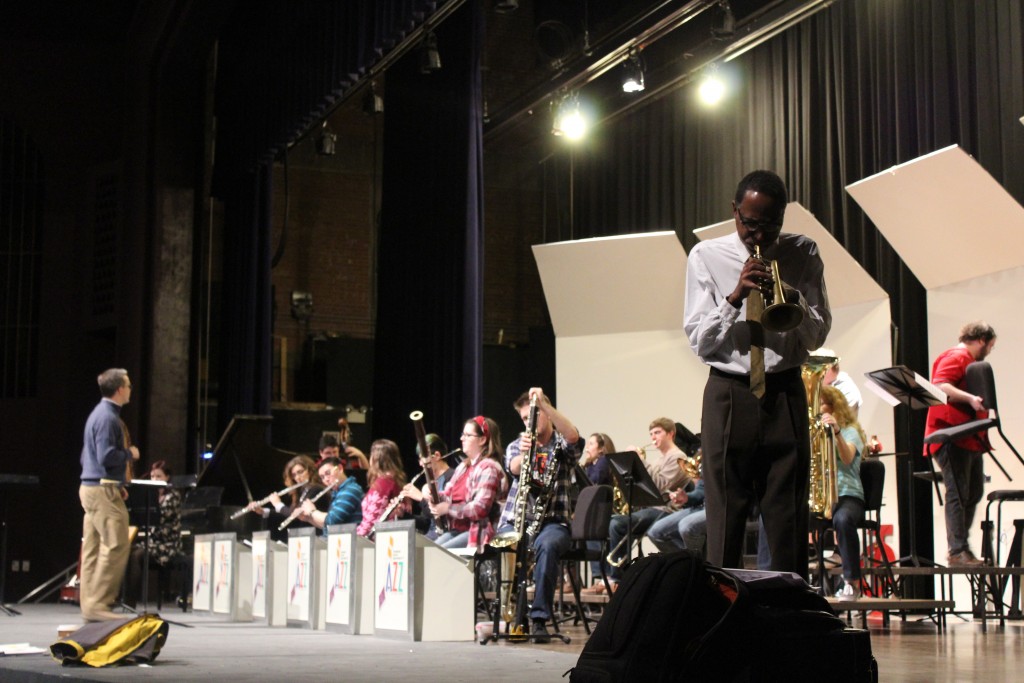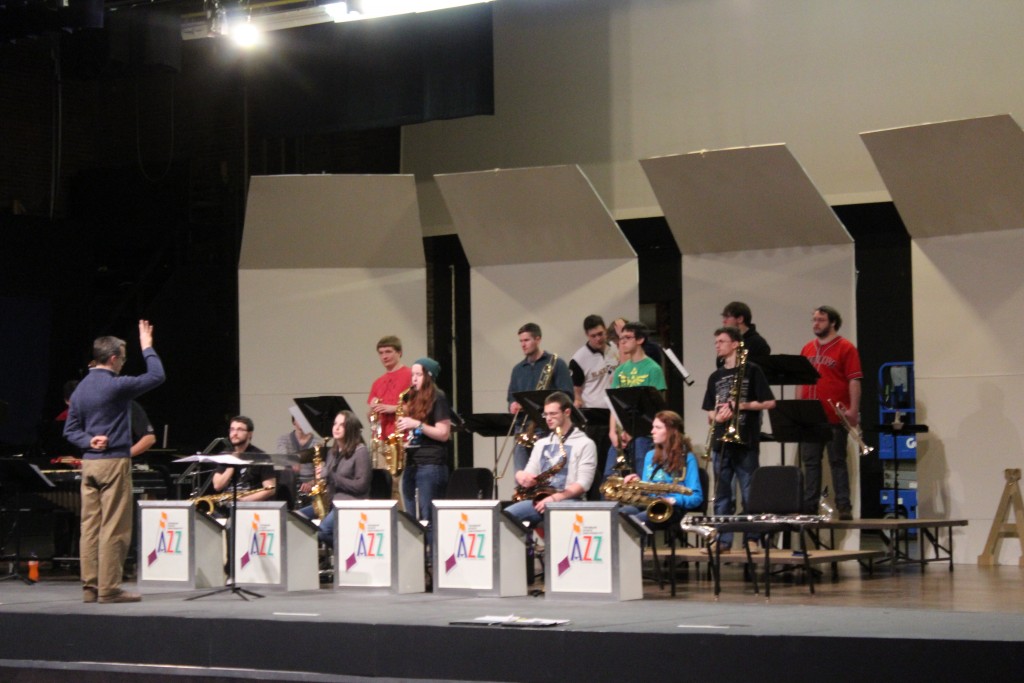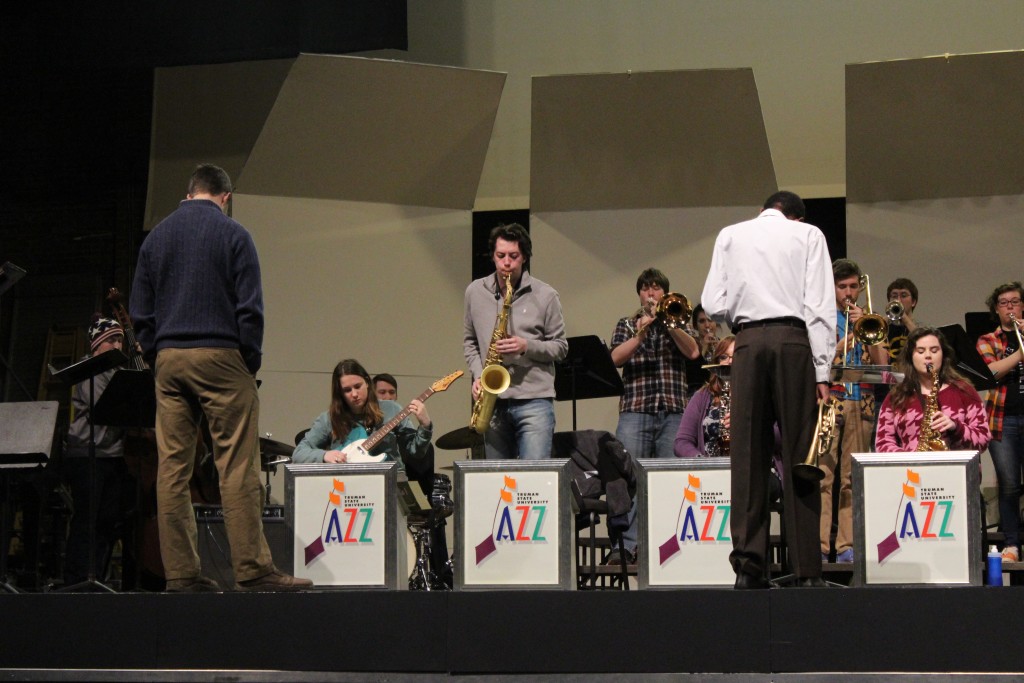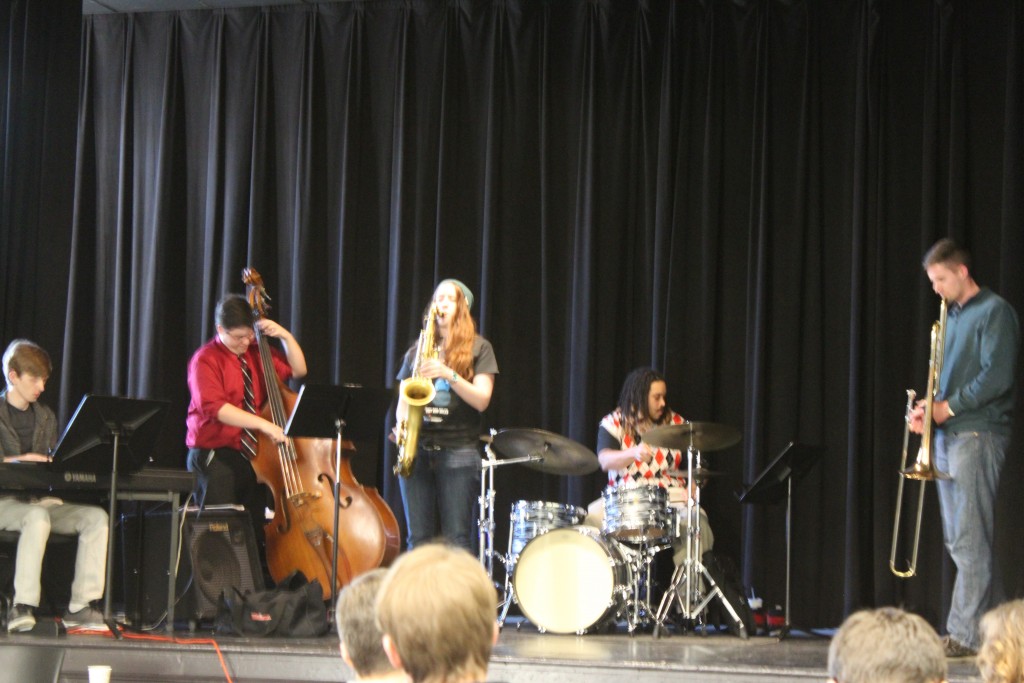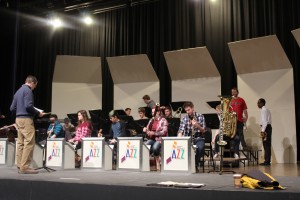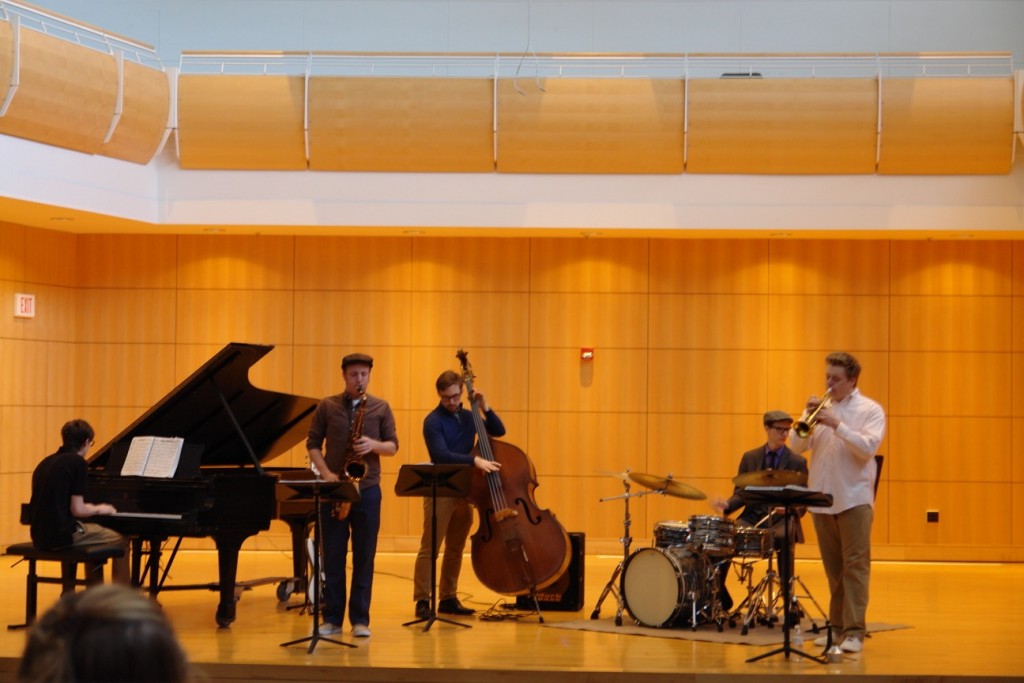TSU Jazz Band Rehearsals–Friday, February 26, 2016
Mid Friday afternoon, I walked into Baldwin auditorium and sat in on a few of the TSU jazz ensemble and jazz lab band rehearsals. Technically these are courses offered by the university, but they make up the big bands that perform during the Saturday evening performance. Because I was not enrolled in these courses, it was difficult for me to actively participate in the rehearsals without being disruptive. Instead, I sat off to the side, took a few photographs, and observed the various forms of interactions: namely, student-student, student-director, student-guest artist, and guest artist-director.
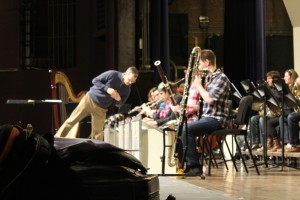
Band director, Prof. Tim AuBuchon, working with a student (Photo by author)
The student-student interactions were nothing unusual; before the jazz director, Professor Tim AuBuchon (known to his students as Mr. A), arrived, they set up on stage, practiced short riffs, and chatted amongst themselves. As classmates, collaborators, and, presumably, friends, they were amiable and relaxed. During this time, they seemed willing to help each other (e.g., ask for advice or opinions), which put everyone on an even playing field, even though some students were more experienced than others.
The dynamic changed slightly when Prof. AuBuchon walked out on stage, but not by much. He said hello, took control of the class, and almost immediately started running through some of the tunes. Aside from his primary role as a teacher, he is the band leader in a similar sense of a conductor of classical music. As the band director, he follows along with the sheet music, but, more importantly, listens to the performance. If something is off, he will have the band run a few bars. When necessary, he will work with a particular section of the band (or, in some cases, with a specific player), to tighten the performance.
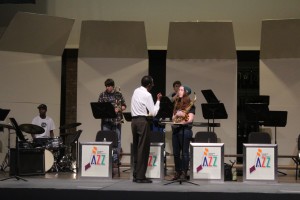
Ron Miles speaking to Lindsey Davis of the TSU Jazz Ensemble (Photo by author)
Shortly after Prof. AuBuchon arrived, JazzFest 48’s featured guest artist, Ron Miles, walked in. Though he was reserved and quiet, but was quick to offer constructive criticism and individual help or advice to students, when necessary. He had a very professional demeanor and was very attentive to the bands he was working with. Within the first few minutes, it was obvious that he was a teacher and he really knew how to talk to students and explain things in ways that they could easily understand. For most, his advice showed immediate results and he managed to elevate the bands’ performances to new heights.
[JazzFest] is an amazing opportunity [for the Truman music students]. I don’t really like big bands, so I don’t play in [the festival], but I did it one year… and it is a different experience playing with someone of that level…. It does not compare to anything. Playing with other people your age who are about as good as you, y’know, it’s fun, but you play with someone who is a professional and has been playing for forever and they’re a master at it, it just makes your playing that much easier and that much more fun. …It’s a really good source of inspiration. Music or anything that you put time into can be kind of a grind–you just get kind of burnt out sometimes–[but playing with a guest artist] is a source of inspiration. It can really just recharge your batteries.
–Zach Green
Prof. AuBuchon. stood nearby, but let Miles take the lead when he wanted. Miles, however, made a point to share directing duties, making sure never to overstep his bounds. In this sense, the two worked more as collaborators or co-directors. Miles paid close attention to the music, appearing to scrutinize ever note. He was never afraid to jump in when he felt it was necessary and run through a few measures. Like AuBuchon, he also took a lot of time to work with individual players or sections to resolve any issues.
Friday Evening Clinic with Ron Miles
After rehearsals, a small clinic was held in the Baldwin “Little Theatre,” down the hall. While anyone could technically attend, this clinic is catered toward the music students in particular. There was a small crowd of about twenty people–again, mostly students, with a couple of PMA alumni and Prof. AuBuchon. The clinic started with a short set by a student combo, including three jazz standards, “Tenor Madness,” “Autumn Leaves,” and “This Land is Your Land.”
When they finished, Miles stood up and inaudibly introduced himself to his audience of enthusiastic jazzers. At first, he kept his eyes to the floor, hesitantly offering feedback. As the combo and the audience grew more and more responsive, he became more confident. Suddenly, Miles lit up and seemed more eager to get engaged; he shifted into teacher-mode and took the combo through an exercise. They practiced playing simple solos, trading eights and sixteens. Someone would come up with a short riff, then the next person would have to play the same, all the while making it something of their own. They did this three times, each time better than the last.
Miles crossed over to the band and sat on the corner of the stage, below the combo and above the audience (an apt place for him, symbolically, since he was the honored guest, but made no attempt to overshadow the up-and-coming jazz musicians). After thanking the band for their patience and praising their performance, he opened a more critical dialogue with the musicians and the audience about the exercise.
He stressed the necessity for musicians to make memorable melodies when soloing. Many people view solos as the time to show off their talent, to woo their audience. While this may be partially true, there is much more to the art of jazz and improvisation. The melodies of the solos, he said, must be as memorable as the tune itself, yet be novel enough to really make the performer stick out. This is true for all musicians, whether from New York City or Denver (his hometown), but especially true for people in small cities like Kirksville. As he explained, “You never know when someone is going to hear you, and that could be your chance.”
He began to say something else, but held back. After a moment, he started into the story of his big break. He grew up in Denver, Colorado, but went to school in New York City. He was playing a lot of classical music at the time, but still a lot of jazz. As he remembers, the way he played at the time drove his music professor insane, causing some tension between the two. A reporter heard him play one night and wrote a raving review of his performance. Almost overnight, he became somewhat of a campus celebrity. His professor realized how wrong he was and stopped criticizing him so much—a point that Miles said he had mixed feelings about. Was it just that review that changed his mind out of embarrassment? Or did he actually think he was good? That aside, this was a pivotal moment in his live. When the opportunity to record an album came around, he was advised to get in contact with some of his favorite musicians, see if they were free to collaborate. He scoured issues of Downbeat and found the contact information for a few players, but none of them responded. Eventually, he made the record anyway and managed to get national airplay of various jazz stations.
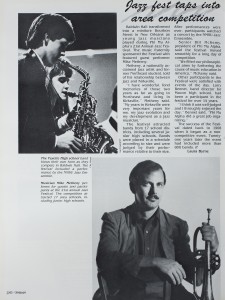
JazzFest 21 featuring Mike Metheny, acclaimed jazz flugelhornist and alumnus of Northeast Missouri State University (Echo, 1989, 252. Courtesy of Pickler Memorial Library)
One day, jazz guitarist, Bill Frisell, was driving and listening to the radio when he heard one of Miles’s tunes. He pulled off the side of the road to listen for the performer’s name. Upon hearing the familiar name, he raced home and found a letter from Miles he had dismissed a few months before. Frisell contacted him immediately, leaving a message on his voicemail. Finally, the two got in touch and ended up collaborating on an album in the early 1990s, which helped put Miles’s name on the map.
It was clear he had not planned to talk about himself much, but his story was appropriate and inspiring to the few present in the room. The point Miles wanted to make was not only the importance of playing well, but for young musicians to always be conscious of playing their best and in the most “you” way possible. With great seriousness, he reminded the students that even in a small town like Kirksville, music critics and professional jazz musicians may pass through and hear them play, and that could be the moment for some of the more serious players to break into the jazz scene. Based on the students’ nonverbal reactions, I also got the sense that some of them felt like Miles could be that person just as easily as anyone else. He did not seem to realize the irony.
Saturday Afternoon Clinic with Ron Miles
The featured clinic on Saturday brought in a much bigger crowd of both TSU students as well as several of the visiting schools. It took place in the Ophelia Parish Performance Hall on campus, which has a similar sort of intimacy as a jazz listening room. This clinic is slightly more formal than the one on Friday, and the combo treats it seriously. They opened with Wayne Shorter’s “Black Nile,” followed by the classic jazz standard “Misty,” and concluded with a more contemporary tune. This set showcased each of the five performers’ abilities and their wide range in musical style and their ability to make even the most familiar tunes sound fresh again. When they finished, Ron Miles walked out on stage and introduced himself to the audience and the band. He made a special point to praise their rendition of “Misty,” clearly impressed by their innovation and talent.
He turned to the audience and introduced himself, then briefly reviewed their set. There were a few spots he wanted to hear again, some because he wanted to work on them and others because he wanted to discuss particularly stunning examples of the group’s musicianship to the audience. Each member received at least five minutes of individual feedback in addition to the advice for the band as a whole.
At one point, Miles suggested the band play a folk tune such as “This Land Is Your Land,” so he could get a sense of how they would approach such a well-known standard and make it their own. They informed him that they arranged a version of “You Are My Sunshine,” which Miles was delighted to hear instead. After singing a verse a cappella, they slid effortlessly into the tune. It swung hard, but sounded so modern without being kitschy or ironic. The group kept the tune familiar, while managing to inject their identity and flair.
When they finished, Miles walked out in awe. He was speechless, so taken aback by the performance. It was the first time I saw him smile; he was so amazed, almost proud, of these young musicians’ performance. He even admitted that he was so impressed, there was no point in giving any criticism and, instead, urged them to keep playing like that.
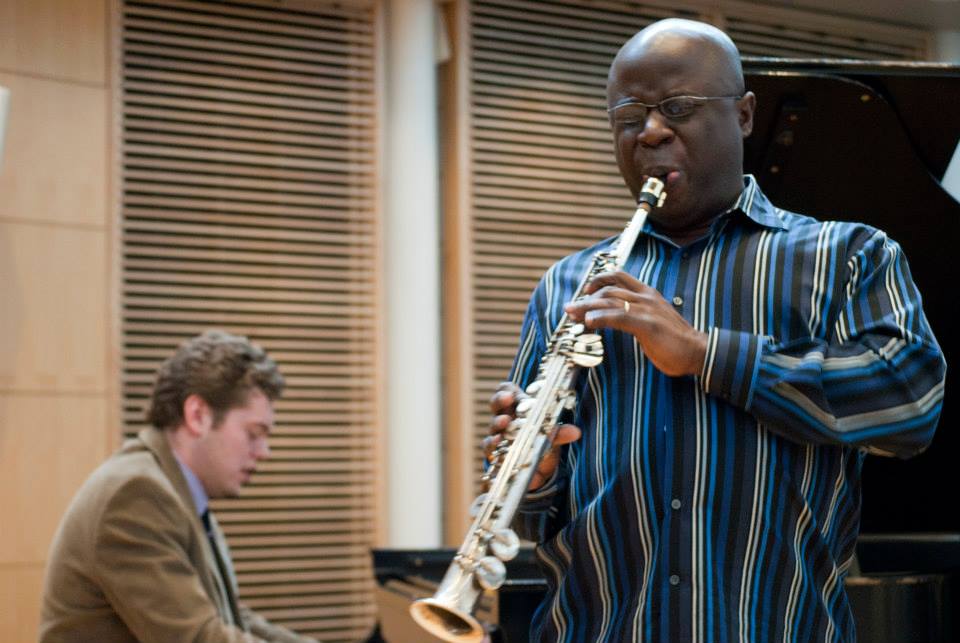
Sam Newsome playing at the JF46 clinic (Photo credit: Justin Borgstede, 2014. Courtesy of the photographer.)
The clinic concluded and the room of about 75 smiling people filed out. There were still a few more clinics for other high schools and middle schools, but the day was coming to an end. The only thing left was the final evening performance later that night.

